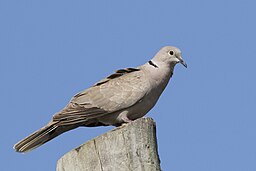
Pidgeon or Dove?
The first thing to know about doves and pigeons is scientifically speaking, they are the same living species. For example, the rock dove (Columba livia) is equally known as the rock pigeon. The word “dove” originates from the Nordic languages, whereas “pigeon” is a word borrowed from French. All doves and pigeons belong to the 300-plus species of birds of the Columbidae family.
The UK has five endemic species of wild doves and pigeons. Here is a brief narrative on those birds:
Collared Dove

Photo credit: Creative Commons/CC BY-SA 4.0
The collared dove (Streptopelia decaocto), also known as the Eurasian collared dove or Turkish dove, is a species native to Europe and Asia. However, introduced during the mid-20th century, it is also well established in North America and some Caribbean islands. While not a migratory bird, the species is strongly dispersive, meaning it constantly seeks to expand its range.
The male and female of the species are both buff-coloured with a distinctive black collar. Both sexes also reach similar lengths (31 – 33 cm) and weight (170 – 250g) on maturity. Collar doves are a monogamous species that can breed throughout the year. Typically, a mating pair of collared doves will produce 3 to 4 broods, annually.
Collar doves can generally be found in suburbia and farmland, that has a ready food source. Across the British Isles, the bird’s range is generally limited to Scotland, the far north of England, central Wales, and the west coast of Ireland. According to the RSPB, there are currently around 800,000 breeding pairs in the UK.
Rock Dove

Photo Credit: Flickr/CC BY-NC-SA 2.0
The rock dove (Columba livia), rock pigeon, or common pigeon is often referred to as just the “pigeon”. It is the species from which all domestic and feral pigeons are descended. The species’ original range was western and southern Europe, North Africa, and some parts of Asia. However, the feral pigeon now thrives across all the world’s continents, except Antarctica.
Male and female rock doves are more or less identical, reaching lengths of between 31 – 34 cm and weighing 230 – 370g on maturity. The bird has a blue/grey body with two distinctive black bands across its wings. The rock dove breeds throughout the year but most prolifically in spring and summer.
The rock dove’s favoured habitat is suburbia and farmland, where food is readily available. However, they can also be found nesting at cliff faces, canyons and caves. Except, perhaps for a few remote populations in Scotland and Ireland, it is thought that almost all the UK’s rock doves have been interbred with feral pigeons. The RSPB estimates the UK’s current rock dove population at 460,000 breeding pairs.
Stock Dove

Photo credit: Flickr/CC BY-NC-SA 2.0
The stock dove (Columba oenas), also known as the stock pigeon, has the widest distribution of all wild dove species. Its natural range covers much of Europe and the western Asiatic region. While the species can be migratory, its UK population remains in residence throughout the year.
The stock dove is very similar in size and plumage to the rock dove. However, the dark bars on its wings are much less pronounced than those of the rock dove. The stock dove’s nesting season starts in early March and continues into late summer. The stock dove can produce up to four broods per year.
The stock dove’s favoured habitat is open countryside. It generally nests in tree trunk cavities, holes in coastal cliffs, ruined buildings, or even abandoned rabbit burrows. The stock dove is distributed across England, Wales, the south of Scotland and east of Ireland. According to the RSBP, the UK has around 320,000 breeding territories of stock dove.
Turtle Dove

Photo credit: Geograph/CC BY-SA 2.0
The turtle dove (Streptopelia turtur) is a migratory species whose range covers most of Europe, the Middle East, Turkey and North Africa. It winters south of the Sahara, appearing in Northern Europe in April and returning south in September.
The turtle dove is the smallest of the UK’s dove species, measuring between 26–28 cm in length and weighing 100–150g. The bird has a pinkish/grey plumage with black/brown wings and distinctive black and white neck markings. Monogamous for life, the turtle dove lays a single batch of two eggs per year, sometime between May and June.
The turtle dove’s favoured habitat is arable farmland, grassland and heathland. They most usually nest in mature hedgerows, open woodland or scrubland. They are generally only found in southern and eastern England between April and September. The RSPB estimates the current UK population at around 3,600 territories.
Woodpigeon

Photo credit: Wikimedia Commons/CC BY-SA 2.0
The woodpigeon (Columba palumbus) is by far the UK’s largest and most abundant species of pigeon. Its range stretches across the whole of Europe, North Africa and the western Asiatic. The species is a migrant from the colder parts of Eastern Europe and Western Asia but a resident, territorial bird in other regions.
A fully grown woodpigeon generally measures between 40 – 42 cm in length and weighs 450 – 600g. It is a grey/blue bird with a reddish/pink chest and distinctive white flashes on its neck and wings. The woodpigeon can breed all year round where food is readily available. Otherwise, breeding is normally restricted to August and September.
The woodpigeon is fully distributed throughout the UK. It is a familiar sight in gardens, parks, woodlands, heathlands and farmlands, across the whole of the country. It builds its nest in trees, hedges, old buildings and other structures. The RSPB estimates the UK’s current woodpigeon population at more than 5 million breeding pairs.
Header image credit: Flickr/CC BY-NC-SA 2






[…] that the feral pigeon now threatens the very existence of its ancestor, the rock dove. For example, in the UK, almost all rock dove populations are deemed to be interbred with feral pigeons. The only […]